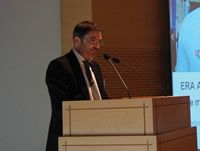Dr Carolin Struller from Bobst Manchester, illustrated the company’s in-depth research on AlOx clear coating, from the way it is produced and its performance on filmic substrates, through to its barrier retention with subsequent processes of printing and converting. Bobst Manchester has carried out extensive trials on the process and is researching ways to enhance their printability and prevent barrier loss during converting.
Kurt Freye and Daniele Cerizzi from Reifenhäuser Kiefel Extrusion and Reifenhäuser Cast Sheet Coating presented the latest developments in blown film and cast extrusion for high barrier applications which reflect the trend for lower pack weights yet with increasing pack performance. This makes nine- to 11-layer films an important trend that has generated several ongoing projects for machines which can produce increasingly sophisticated multilayer structures using less material.
Talking about short-run gravure printing, Stuart Jones of Janoschka discussed his company’s innovative work on rotogravure sleeve systems, as well as retail trends for mass customisation.
Professor Armin Weichmann from Stuttgart Media University illustrated studies being carried out on conductive layers, cylinder stability and the feasibility of nickel to replace copper and chromium in engraved cylinders. He also focused on the value of the Rotomec MW 60 gravure press installed in the university’s press room as a key part of all its projects, where it replicates productions conditions – essential for the validity of trials carried out on the behalf of converters.
The gravure technology update was rounded up by Giovanni Caprioglio from Bobst Italia, who illustrated the comprehensive range of Bobst gravure presses for flexible materials, focusing on the MW (Minimised Waste) concept of the Rotomec MW 60 ? 80 press. Dedicated to very short-run printing, the Rotomec MW 80 brings together all the essential requisites for profitable operation, namely minimised waste of material, minimised energy consumption and minimised space requirement.
Of great interest to all participants was the insightful presentation of Philippe Roulet from Nestlé, who illustrated all the factors that determine the way packaging needs to evolve in order to better respond to the new and diverse requirements of the consumer. Breaking the rules, generating value for the consumer, streamlining and standardising the structures of materials wherever possible, and implementing new technologies into processes were just a few of the key issues presented.
Rotomec MW 80 demonstrated
After lunch at the castle, the action moved to the nearby Bobst Italia Technology Centre, where an 850mm web-width Rotomec MW 80 awaited guests, printing a demo job on a 12µm PET substrate coated with AlOx.
Among highlights of the demonstration was the capability of Bobst technology to handle AlOx coated substrates which, compared to conventional films, present challenges to printing and converting equipment. A further highlight was the effectiveness of the MW 80 on-board washing system. The print run also showed the validity of the MW concept, starting with the TAPS function to set the machine in register. At the completion of the TAPS sequence, which lasted a few minutes, the screen on the machine registered incomparable low substrate waste.
After an automatic splice, carried out on the rewinder at maximum speed, a print sample master was collected before changing the colour on one print unit from light peach to very dark brown and resuming printing at full production speed. The speed of changeover being very critical in terms of profitability when printing very short runs, an operator demonstrated how fast and easy it was on a print unit which was in stand-by during printing. After a few minutes of printing, the machine was stopped and the washing sequence of the cylinder and ink pan started on a selected print unit, prior to the ink being changed back from dark brown to the original light peach colour.
Guests followed the on-board washing sequence from animations displayed on a screen, whilst also being able to check on a separate screen the register accuracy and stability, most particularly during acceleration and deceleration. After another automatic splice at maximum production speed, the machine was stopped and a second sample taken in order to measure the colour difference with the print sample master. The Delta E value between the two compared samples was very low, clearly showing the efficiency of the Bobst internal washing system in avoiding contamination from one colour to the other, especially considering the great difference of shades in reverting from a very dark brown intermediate colour. Once the demonstration was over, guests were able to get close to the machine to see the results of the washing sequences from the ink pan and cylinders which were taken out of the MW 80 press for checking.
A demonstration on the Bobst CL 850D, confirmed the laminator’s quality, efficiency and flexibility. The machine, featuring the renowned Bobst flexo coating system, laminated a 7µm aluminium substrate onto a 12µm PET film. The Rotomec system enables a lower coating weight of solvent-based adhesive to be applied directly to the aluminium foil, creating excellent bond strength. The machine produced a flawless, high quality, duplex laminated structure at a speed of 430m/min.









